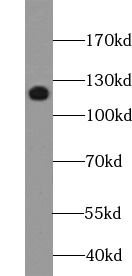Products
MUC1 antibody
| Synonyms: | Mucin-1 (MUC-1)|Breast carcinoma-associated antigen DF3|Cancer antigen 15-3 (CA 15-3)|Carcinoma-associated mucin|Episialin|H23AG|Krebs von den Lungen-6 (KL-6)|PEMT|Peanut-reactive urinary mucin (PUM)|Polymorphic epithelial mucin (PEM)|Tumor-associated epithelial membrane antigen (EMA)|Tumor-associated mucin|Mucin-1 subunit alpha (MUC1-NT antibody, MUC1-alpha)|Mucin-1 subunit beta (MUC1-beta) Alternative names: MUC1-CT|MUC1|PUM antibody | ||
| Catalogue No.: | FNab05427 | Reactivity: | Human, Mouse, Rat |
| Host: | Rabbit | Tested Application: | ELISA, WB, IHC |
| Clonality: | polyclonal | Isotype: | IgG |
| Size | Price |
|---|---|
| 100µg | Inquiry |
- SPECIFICATIONS
- FIGURES
- CONDITIONS
- FAQS
- Product Name
- MUC1 antibody
- Catalogue No.
- FNab05427
- Size
- 100μg
- Form
- liquid
- Purification
- Immunogen affinity purified
- Purity
- ≥95% as determined by SDS-PAGE
- Clonality
- polyclonal
- Isotype
- IgG
- Storage
- PBS with 0.02% sodium azide and 50% glycerol pH 7.3, -20℃ for 12 months(Avoid repeated freeze / thaw cycles.)
- Immunogen
- mucin 1, cell surface associated
- Alternative Names
- Mucin-1 (MUC-1)|Breast carcinoma-associated antigen DF3|Cancer antigen 15-3 (CA 15-3)|Carcinoma-associated mucin|Episialin|H23AG|Krebs von den Lungen-6 (KL-6)|PEMT|Peanut-reactive urinary mucin (PUM)|Polymorphic epithelial mucin (PEM)|Tumor-associated epithelial membrane antigen (EMA)|Tumor-associated mucin|Mucin-1 subunit alpha (MUC1-NT antibody, MUC1-alpha)|Mucin-1 subunit beta (MUC1-beta) Alternative names: MUC1-CT|MUC1|PUM antibody
- UniProt ID
- P15941
- Observed MW
- 122 kDa、23-30 kDa
- Tested Applications
- ELISA, WB, IHC
- Recommended dilution
- WB: 1:500-1:5000; IHC: 1:20-1:200
 A431 cells were subjected to SDS PAGE followed by western blot with FNab05427(CA15-3,MUC1 antibody) at dilution of 1:1500
A431 cells were subjected to SDS PAGE followed by western blot with FNab05427(CA15-3,MUC1 antibody) at dilution of 1:1500
 Immunohistochemistry of paraffin-embedded human lung cancer using FNab05427(CA15-3,MUC1 antibody) at dilution of 1:50
Immunohistochemistry of paraffin-embedded human lung cancer using FNab05427(CA15-3,MUC1 antibody) at dilution of 1:50
- Background
- The alpha subunit has cell adhesive properties. Can act both as an adhesion and an anti-adhesion protein. May provide a protective layer on epithelial cells against bacterial and enzyme attack.The beta subunit contains a C-terminal domain which is involved in cell signaling, through phosphorylations and protein-protein interactions. Modulates signaling in ERK, SRC and NF-kappa-B pathways. In activated T-cells, influences directly or indirectly the Ras/MAPK pathway. Promotes tumor progression. Regulates TP53-mediated transcription and determines cell fate in the genotoxic stress response. Binds, together with KLF4, the PE21 promoter element of TP53 and represses TP53 activity.
How many times can antibodies be recycled?
First, usually it's not suggested to recycle antibodies. After use, buffer system of antibodies has changed. The storage condition of recycled antibodies for different customers also varies. Thus, the performance efficiency of recycled antibodies can’t be guaranteed. Besides, FineTest ever conducted the antibody recycling assay. Assay results show recycling times of different antibodies also varies. Usually, higher antibody titer allows more repeated use. Customers can determine based on experimental requirements.
Notes: After incubation, we recycle rest antibodies to centrifuge tube and store at 4℃. High titer antibodies can be stored for a minimum of one week. Reuse about three times.
What are components of FineTest antibody buffer?
Components of FineTest antibody buffer are usually PBS with proclin300 or sodium azide, BSA, 50% glycerol. Common preservative is proclin300 or sodium azide, which is widely applied in the lab and industry.
How about the storage temperature and duration of FineTest antibodies?
Most antibodies are stored at -20℃. Directly-labeled flow cytometry antibodies should be stored at 2 - 8℃. The shelf life is one year. If after sales issues for purchased antibodies appear, return or replacement is available. Usually, antibodies can be still used after the one-year warranty. We can offer technical support services.
Is dilution required for FineTest antibodies? What’s the dilute solution?
Directly-labeled flow cytometry antibodies are ready-to-use without dilution. Other antibodies are usually concentrated. Follow the dilution ratio suggested in the manual. Dilute solution for different experiments also varies. Common antibody dilution buffers are acceptable(e.g. PBST, TBST, antibody blocking buffer).
How to retrieve antibodies for immunohistochemistry?
Common retrieval buffers: Tris-EDTA Buffer(pH 9.0); Citrate Buffer(pH 6.0)
Heat induced antibody retrieval:
Method 1: Water-bath heating: Put the beaker with retrieval buffer and slide in the boiling water bath. Keep the boiling state for 15min. Naturally cool to room temperature;
Method 2: Microwave retrieval: Put the beaker with retrieval buffer and slide in the microwave oven. Heat at high power for 5min, Switch OFF for 3min, Heat at medium power for 5min. Naturally cool to room temperature.
How to choose secondary antibodies?
(1) Secondary antibodies react with primary antibodies. Thus, secondary antibodies should be against host species of primary antibodies. E.g. If the primary antibody is derived from rabbit, the relevant secondary antibody should be against rabbit. E.g. goat anti rabbit or donkey anti rabbit.
(2) Choose secondary antibody conjugates according to the experimental type, e.g. ELISA, WB, IHC etc. Common enzyme conjugated secondary antibodies are labelled by HRP, AP etc. Fluorescin or dye labelled secondary antibodies are applied in immunofluorescence and flow cytometry(e.g. FITC, Cy3).
